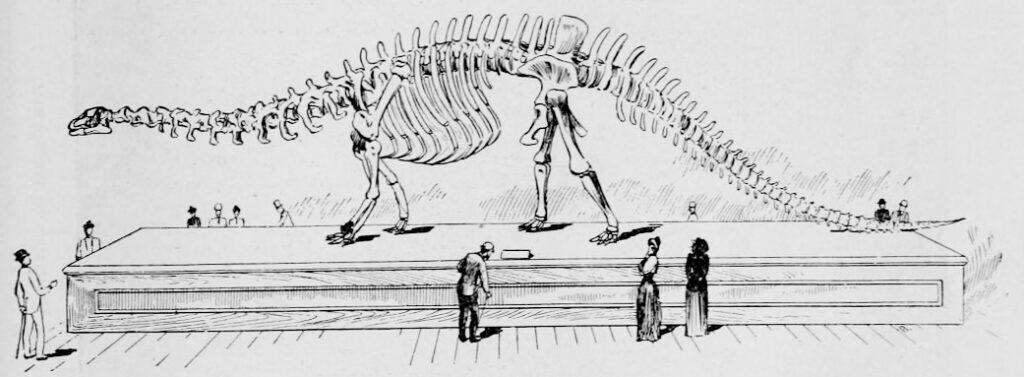Only one fossil has been found for this dinosaur and it was lost very soon after discovery.
Advertisement
Amphicoelias Fragillimus Scientific Classification
- Kingdom
- Animalia
- Phylum
- Chordata
- Order
- Sauropoda
- Family
- Diplodocoidea
- Genus
- Amphicoelia
- Scientific Name
- Amphicoelias Fragillimus
Read our Complete Guide to Classification of Animals.
Amphicoelias Fragillimus Conservation Status
Amphicoelias Fragillimus Facts
Amphicoelias Fragillimus Physical Characteristics
- Skin Type
- Scales
View all of the Amphicoelias Fragillimus images!
“The Amphicoelias fragillimus had no natural predators due to its enormous size.”
Summary
The Amphicoelias fragillimus was among the largest dinosaurs that ever lived. This giant Sauropod lived 140 to 160 million years ago during the Jurassic period. Its fossils were found in Colorado. The Amphicoelias fragillimus was an herbivore that used its extraordinarily long neck to eat leaves from high trees in forests and grasslands. This species is identified from a single fossil specimen, so the size estimates of this animal have varied immensely over the years. Although only a single fossil was found, this fossil is estimated to be the largest dinosaur specimen ever discovered.
Scientific Name
Amphicoelias fragillimus
The name Amphicoelias fragillimus can be divided into two parts: Amphicoelias means “double hollow” and refers to the thin walls of the animal’s vertebrae. This adaptation occurred so that the huge dinosaur could easily support its large skeleton. Fragillimus literally means “fragile,” owing to how thin all the bones were. This species was named by Edward Drinker Cope, a paleontologist who found the initial samples of the animal in 1877. The Amphicoelias fragillimus is closely related to other giant Sauropods, most notably the Diplodocus.
Description & Size
The Amphicoelias fragillimus was a massive animal with a long neck, short legs, and an extended tail. Considering the dinosaur’s size, it weighed much less than you would think due to its thin, hollow bones. Outwardly, these animals are thought to have had scaly, brown skin and a small head in comparison to the rest of their body. Their physical features were as follows:
| Length | 130-200 ft |
| Single vertebral Length | 5-8 ft |
| Weight | 200,000 to 300,000 lbs |
| Neck Length | 45-60 ft |
To put their length into perspective, it would take you around 80 footsteps to walk the length of the average Amphicoelias fragillimus. In terms of weight, it was around two-thirds that of a blue whale.

The
Amphicoelias fragillimuswas a massive animal with a long neck, short legs, and an extended tail.
©The Californian Vol. 1, 1892/Public Domain – License
Diet – What Did the Amphicoelias Fragillimus Eat?
The Amphicoelias fragillimus was an herbivore, meaning its diet was based solely on plants. They had a long and slow digestive system. And similar to other massive animals living today, such as elephants and giraffes, their slow digestion allowed them to eat less nutritious food and thrive on fewer calories than an animal of this size would otherwise need.
Since they lived in terrestrial areas of the United States, they fed on plants such as ferns and leaves as their primary diet. Other food sources include gingko, cycads, seed ferns, horsetails, and club mosses. This dietary analysis is entirely based on data gathered from fossils. Thus, their diet is entirely based on speculation, and we might discover something new in the future.
Habitat – When and Where It Lived?
The Amphicoelias fragillimus lived between the Kimmeridgian to Tithonian eras of the Jurassic period. This was roughly 145 to 160 million years ago. The habitat of these behemoths was likely a lush tropical savannah, covered in greenery for them to eat, a typical habitat for giant sauropods. Cope discovered the single fossil specimen in Garden Park, Colorado. This is the only confirmed location of the species, although it is likely it also lived in other regions.
Threats and Predators
As mentioned above, this gigantic diplodocid dinosaur belongs to a family of massive sauropods with long necks, thin bones, and huge bodies. Considering it was one of the largest dinosaurs during its time, the chances of other animals preying on it were rather slim. The only threat the animal possibly faced was climate change and other sauropod dinosaurs living in the same habitat, fighting over food and possible mates.
Discoveries and Fossils – Where It Was Found
The fossils of the Amphicoelias fragillimus were discovered in the Colorado mudstone in fragmented rock. Since the fossil evidence was only part of a single vertebra, paleontologists used a sketch to estimate the size and skeletal structure of the rest of the dinosaur.
Unfortunately, the fossil disappeared very soon after its discovery, and only one scientist, Edward Drinker Cope, was able to study the specimen. All current size estimations and descriptions of the animal are based on the original sketch, study, and observations from Edward Drinker Cope made in 1877.
Extinction – When Did It Die Out?
The animal lived during the Late Jurassic period. Thus, it most likely went extinct during the Jurassic – Triassic extinction period. This was the most severe extinction event in natural history, during which 76 percent of all species on the planet died out. This occurred due to the rapidly changing temperatures and rising sea levels. These animals were likely not very adaptable to changing weather conditions due to their large size.
Similar Animals to the Amphicoelias Fragillimus
Similar dinosaurs to the Amphicoelias fragillimus include:
- Patagotitan – A large Sauropod native to Patagonia in modern-day Argentina. This animal was about the same size as the Amphicoelias framillimus.
- Camarasaurus – A quadrupedal herbivore with almost the same weight as Amphicoelias fragillimus.
- Argentiosaurus – A gigantic herbivore dinosaur, estimated to be the largest dinosaur ever, almost the same length as Amphicoelias fragillimus.
- Supersaurus – Another large, herbivore sauropod from the North American region.
Amphicoelias Fragillimus FAQs (Frequently Asked Questions)
When was the Amphicoelias fragillimus alive?
This giant Sauropod lived 140 to 160 million years ago during the Jurassic period.
How big was the Amphicoelias fragillimus?
This species is identified from a single fossil specimen, so the size estimates of this animal have varied immensely over the years. Although only a single fossil was found, this fossil is estimated to be the largest dinosaur specimen ever discovered.
Thank you for reading! Have some feedback for us? Contact the AZ Animals editorial team.
Sources
- Prehistoric Wildlife, Available here: http://www.prehistoric-wildlife.com/species/a/amphicoelias.html
- Kid ADL, Available here: https://kidadl.com/facts/dinosaurs/maraapunisaurus-facts
- Fossil Fandom, Available here: https://fossil.fandom.com/wiki/Amphicoelias
- All the Science, Available here: https://www.allthescience.org/what-is-amphicoelias-fragillimus.htm
















